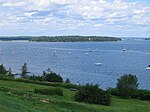Baxter Summer Home
Baxter familyBuildings and structures in Falmouth, MaineHouses completed in 1917Houses in Cumberland County, MaineHouses on the National Register of Historic Places in Maine ... and 2 more
National Register of Historic Places in Cumberland County, MaineRenaissance Revival architecture in Maine

The Baxter Summer Home is a historic house on Mackworth Island, in Casco Bay off the coast of Falmouth, Maine. Now a centerpiece of the campus of the Governor Baxter School for the Deaf, the house was built in 1917–18 by James Phinney Baxter, and was given (along with the rest of the island) to the state by his son Percival, a two-term Governor of Maine best known for establishing Baxter State Park. The house was listed on the National Register of Historic Places in 1985.
Excerpt from the Wikipedia article Baxter Summer Home (License: CC BY-SA 3.0, Authors, Images).Baxter Summer Home
Andrews Avenue,
Geographical coordinates (GPS) Address Phone number Website Nearby Places Show on map
Geographical coordinates (GPS)
| Latitude | Longitude |
|---|---|
| N 43.688055555556 ° | E -70.233055555556 ° |
Address
Maine Educational Center for the Deaf and Hard of Hearing
Andrews Avenue 1
04105
Maine, United States
Open on Google Maps







